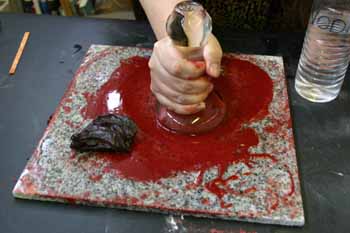
Angel Gabriel by Vladislav Andrejev
During my college years, I had the great blessing of being able to study for a time at School of the Sacred Arts (SOSA) in NYC. It was an amazing place which gathered masters from many diverse spiritual traditions, teaching everything from Haiku, Tibetan butter sculpture, manuscript illumination, Russian Icon writing (painting), Tibetan Tonka painting, Indian dance, Chinese calligraphy and on and on. There were also lectures on mysticism and sacred traditions by scholars and spiritual leaders. Everything was geared to help you enter into and experience sacred mystical traditions, ground and guided by true masters. It was an amazing place which sadly closed years ago. It was here that I first met Lex Hixon, Karen Gorst (my co-author on Lapis & Gold) and studied Icon writing with Vladislav Andrejev.
Vladislav is an amazing man who radiates spirituality. I was in school at NYU and had to walk across Washington Square park to my Icon class in the old church that SOSA had taken over. I would often come upon Vladislav sitting on a bench deep in prayer in preparation for his class.Let me put it kindly, I was not a success at Icon writing. This class was probably my first conscious, overtly spiritual struggle and my first awareness of my ego's roll in defining my life.
To write an Icon, you have to set aside your ideas and submit to the form, following the master's instructions entirely. At that time, this was impossible for me. Directions and me didn't mix. I used to brag that I couldn't even follow the directions on a box of Kraft macaroni and cheese and it was true. Not because I was unable read the instructions or understand them, but because my need to control was so profound. I couldn't even follow the simplest instruction from someone, even written on a box, without arguing.
I wanted to write an Icon, but I want to "express myself" more. I was angry at being confined. I worked on an Angel Gabriel Icon and I was incensed that I could not alter the image at all to put my stamp on it. I was angry that I couldn't choose my own colors for the many layers that built Gabriel's face and clothing. It was absurd. I had big plans, but my plans interfered with my ability to write an Icon and striped me of the intimate knowledge and spiritual truths contained in that process.In Icon writing everything has form, order and meaning. Order and form are strictly prescribed. You must travel their path to get to meaning. You can intellectually understand the meaning, but it will have no impact on your spirit without surrendering completely into the process. Only in this way will mind and spirit become one in knowledge and can you grow spiritually.Vladislav's class made it very clear to me that I had a problem. Through him, for the first time, I began to be aware of how ego was dominating my life. Of course, nothing shifted then. It took me twenty years and 10 days in the cardiac ICU to learn to surrender. But the awareness first came from him, through the process of Icon writing. It is an art, like manuscript illumination, which has deep spiritual effects on the artist. It demands the artist be healed through its process because it's goals are so profound.Icons are meant to be windows to God. They seek to remove the veils between the Divine and humanity. They are filters that allow a more pure resonance of God's light to pour into the world. Theodore Roethke said:
Form is not regarded as a neat mould to be filled, but rather as a sieve to catch certain kinds of material.
This is a profound statement. We are not simply empty vessels to be filled with anything that comes along. We have a choice to filter and hold what is dear to us. Although we are vessels, we are active participants too.What I didn't understand yet in Vladislav's class is that our only work here is opening the door for Divine Light, that some more true expression of the Self can emerge from surrendering the self, and that we are filters and windows too, walking Icons. While written Icons capture a timeless moment of peace and surrender harnessed by the spiritual surrender of the artist, we move through time. Each moment becomes a choice- what will we filter, what will we surrender? What kind of window will we build, one filled with an an opaque and dirty glass or one luminous, bridging two worlds?Vladislav now teaches at Prosopon School of Iconology and has just released a set of instructional DVDs. Here is a short excerpt:To see more excerpts or order the DVD go to the Prosopon School of Iconology website and click "Process" on the left sidebar. I believe after 20 years of work I may finally be ready to be a beginning Icon writer. I am ordering this video.


